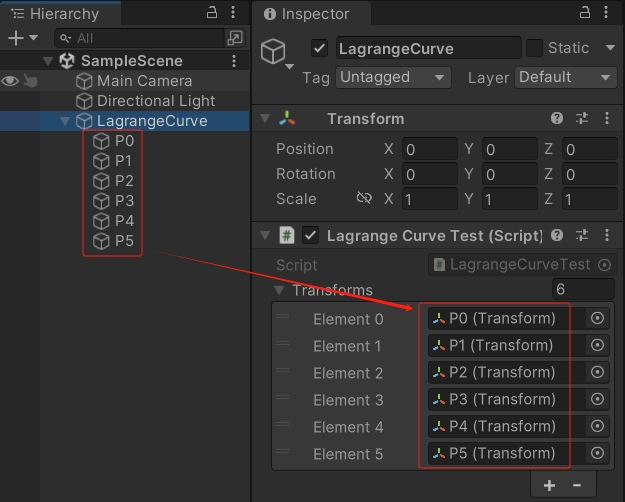Unity拉格朗日曲线插值
post by:追风剑情 2024-10-12 21:56
一、工程截图
二、插值脚本
using UnityEngine;
/// <summary>
/// 拉格朗日曲线插值类
/// </summary>
public sealed class LagrangeCurve
{
/// <summary>
/// 拉格朗日曲线插值算法
/// </summary>
/// <param name="points">型值点</param>
/// <param name="t">插值参数,取值范围[0,1]</param>
/// <returns></returns>
public static Vector3 Lerp(Vector3[] points, float t)
{
//--参数有效性检测--
if (t < 0) t = 0;
if (t > 1) t = 1;
if (points == null || points.Length == 0)
return Vector3.zero;
if (points.Length == 1)
return points[0];
//--End--
//直接返回起始点
if (t <= 0)
return points[0];
//直接返回终点
if (t >= 1)
return points[points.Length-1];
Vector3 result = Vector3.zero;
//路径总长度
float s = 0;
//存放每个型值点所在位置的路径长度
float[] lengths = new float[points.Length];
lengths[0] = 0;
for (int i = 1; i < points.Length; i++)
{
float d = Vector3.Distance(points[i - 1], points[i]);
s += d;
lengths[i] = s;
}
//计算线性插值距离
float l = s * t;
//临时变量
float x=0, y=0, z=0;
int count = points.Length;
//算法实现
for (int i = 0; i < count; i++)
{
Vector3 p = points[i];
x = p.x;
y = p.y;
z = p.z;
//型值点的值与混合函数值相乘
for (int j = 0; j < count; j++)
{
if (i == j)
continue;
float ti = lengths[i];
float tj = lengths[j];
t = (l - tj) / (ti - tj);
x *= t;
y *= t;
z *= t;
}
//线性组合
result.x += x;
result.y += y;
result.z += z;
}
return result;
}
}
using System.Collections;
using System.Collections.Generic;
using UnityEngine;
public class LagrangeCurveTest : MonoBehaviour
{
[SerializeField]
private List<Transform> transforms = new List<Transform>();
private Vector3[] points;
private void Update()
{
points = new Vector3[transforms.Count];
for (int i = 0; i < transforms.Count; i++)
{
points[i] = transforms[i].position;
}
float step = 0.01f;
float t = 0f;
while(t < 1)
{
Vector3 v0 = LagrangeCurve.Lerp(points, t);
t += step;
Vector3 v1 = LagrangeCurve.Lerp(points, t);
Debug.DrawLine(v0, v1, Color.red);
}
}
}
评论:
发表评论:

